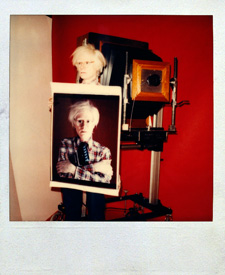 A treasure trove of Andy Warhol’s work has been presented to the Williamson Gallery of Scripps College: 100 Polaroid photos and 50 gelatin silver prints, valued at close to $150,000. The works were created roughly between 1978 and 1985.
A treasure trove of Andy Warhol’s work has been presented to the Williamson Gallery of Scripps College: 100 Polaroid photos and 50 gelatin silver prints, valued at close to $150,000. The works were created roughly between 1978 and 1985.
As recipient, Scripps joins a group of 183 college and university art museums across the U.S. to be presented with Warhol’s works by the Andy Warhol Foundation for the Visual Arts. The gifts were donated through the Andy Warhol Photographic Legacy Program in honor of the foundation’s 20th anniversary, and consist of 28,543 original Warhol photographs. The value of these works exceeds $28 million.
Mary MacNaughton, Williamson Gallery director, said, “This extraordinary gift of 150 photographs by Warhol will give students an immediate and tangible means of understanding the work of one of the most important artists of the 20th century, one whose influence is still felt on contemporary art today.”
The aim of the Photographic Legacy Program is to provide greater access to Warhol’s artwork and process, and to enable a wide range of people from communities across the country to view and study this important yet relatively unknown body of Warhol’s work. The program’s goals dovetail nicely with those of the Williamson Gallery and Scripps College. Mary MacNaughton notes that “we use the permanent collection in conjunction with teaching. When not on display, these Warhol photographs are available for students and the public to see in the new C. Jane Hurley Wilson and Michael G. Wilson Photograph and Print Study Room. To make an appointment, call Kristin Miller at (909) 607-8090.”
Of particular interest to many Scripps students and faculty members is the way these photos reveal insights about how Warhol worked. Jenny Moore, curator of the Photographic Legacy Program, commented: “A wealth of information about Warhol’s process and his interactions with his sitters is revealed in these images. Through his rigorous — though almost unconscious — consistency in shooting, the true idiosyncrasies of his subjects were revealed. Often, he would shoot a person or event with both cameras, cropping one in Polaroid color as a ‘photograph’ and snapping the other in black and white as a ‘picture.’ By presenting both kinds of images side by side, the Photographic Legacy Program allows viewers to move back and forth between moments of Warhol’s ‘art,’ ‘work,’ and ‘life’ — inseparable parts of a fascinating whole.”

